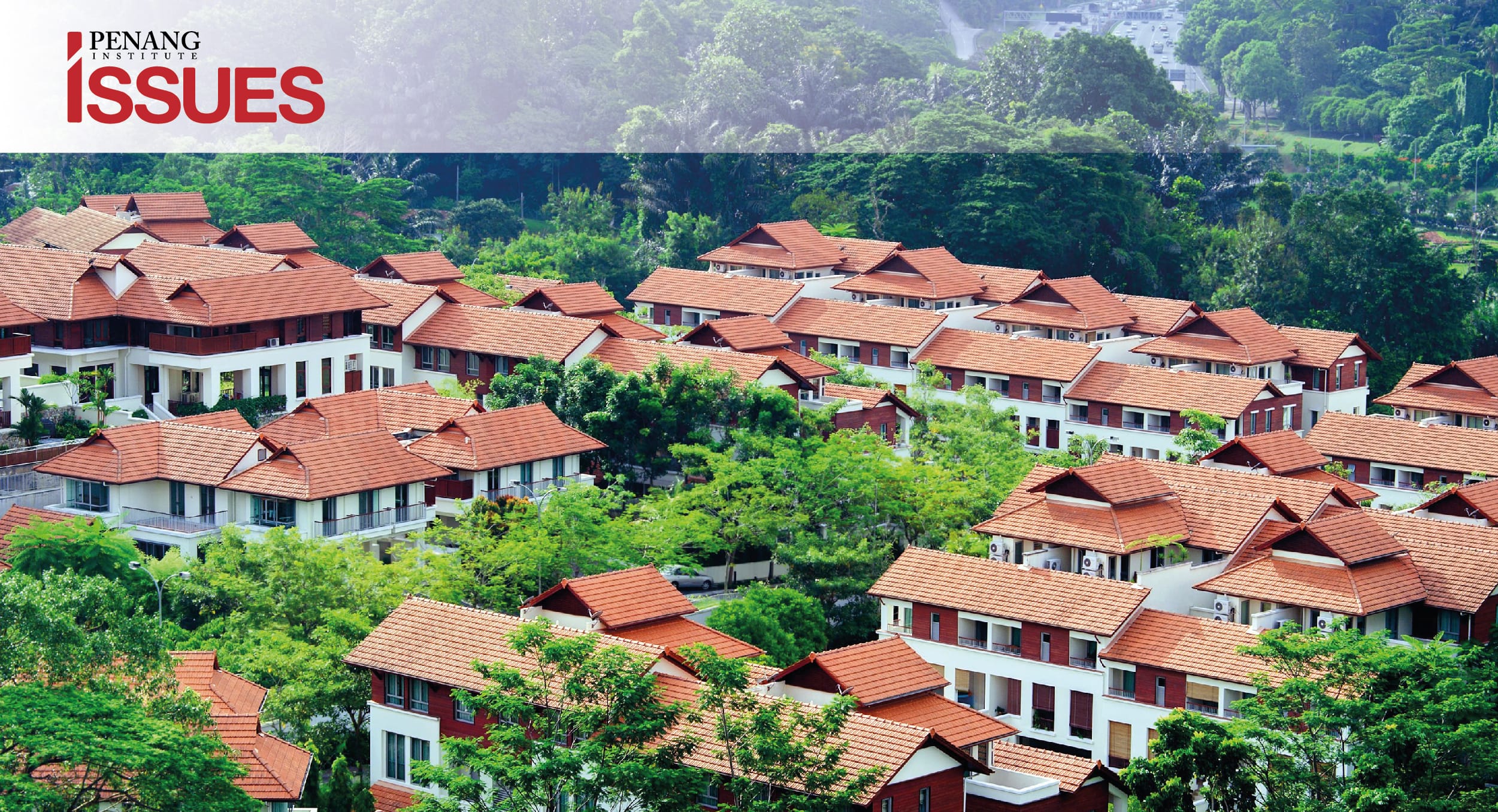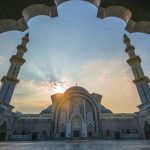Executive Summary
- This paper examines the new Malaysia My Second Home (MM2H) requirements. It argues that drastic changes to them will disqualify existing applicants and deter prospective ones from choosing Malaysia as a destination for long-term residence, and will not benefit the country’s economy.
- In comparison to requirements that are in place in The Philippines, Thailand, and Indonesia, Malaysia’s new MM2H requirements are less attractive.
- Nonetheless, it is timely for Malaysia to review the MM2H requirements, especially when the previous requirements did have loopholes for applicants to abuse.
- This paper argues that changes to MM2H requirements should be gradual and transparent. In addition, the Immigration Department and Ministry of Tourism, Arts, and Culture should work together to promote the programme without compromising security concerns.
Introduction
Introduced in 2002, the Malaysia My Second Home (MM2H) programme is an international retirement migration (IRM) programme aimed at attracting foreign retirees or high income earners to choose Malaysia as their place of residence. Originally meant for applicants above 50 years old as a retirement programme, applicants below the age of 50 who meet the stipulated MM2H criteria have since 2009 been permitted to apply as well.
The MM2H programme provides a social visit pass and a multiple entry visa from the Malaysian Immigration Department, valid for ten years and is renewable. This means that participants may enter and leave Malaysia whenever they wish. Participants are also allowed to invest in or start a business in Malaysia, subject to domestic regulations.
The MM2H programme also contributes to the Malaysian economy. From 2002 to 2019, the MM2H programme generated RM 11.89 billion for the economy through visa fees, purchase of real estate and private vehicles, fixed deposits, and household spending.[1] A study shows that the average monthly spending of MM2H participants is about RM6,030.[2]
In general, MM2H has been able to achieve its goal of attracting foreigners to Malaysia for long-term residence or as a destination for retirement. In fact, Malaysia was ranked fifth in 2018 and 2019 and seventh in 2020 on the list of the world’s best retirement havens, collated by International Living.[3] In 2017 alone, it is estimated that there were more than 48,000 participants from 127 countries[4] who were granted long-term visit passes under the MM2H programme.[5] These participants are distributed throughout Malaysia, in Kuala Lumpur and Selangor, Penang, Perak, Melaka, and parts of East Malaysia.
However, the previous MM2H requirements do not stipulate an annual minimum duration that participants need to stay in Malaysia,[6] and the Immigration Department does not monitor who resides here or who holds the visa but lives outside the country.[7] Therefore, the exact number of participants who have actually resided in Malaysia is not clear.
Despite the success of MM2H, the programme was abruptly suspended in 2018, only to be reopened three months later. Although no official explanation was given for the sudden suspension, it was reportedly because of a dispute between the Ministry of Tourism, Arts and Culture (MOTAC) and the Ministry of Home Affairs (KDN) on whether MM2H should remain under MOTAC or be placed under the purview of the Immigration Department. It was subsequently decided that from April 2019 onwards, the programme will still be administered by MOTAC but with KDN’s final approval.[8]
In 2020, the MM2H programme was suspended again due to the Covid-19 pandemic. The programme is being re-launched in October 2021, albeit with much stricter requirements and will be administered by the Immigration Department.[9] These new requirements have caused much consternation among existing MM2H participants, prospective MM2H applicants, as well as MM2H agents who facilitate these applications. The fate of those who have already enrolled in the programme is unclear, as their situation is still under review by Home Minister Hamzah Zainuddin.
This paper examines how these new requirements will deter prospective applicants from choosing Malaysia as their residence by comparing the new and old MM2H requirements as well as similar programmes of neighbouring countries. Before that, the paper will briefly look at some statistics of the programme.
MM2H-approved Participants from 2002 to 2018
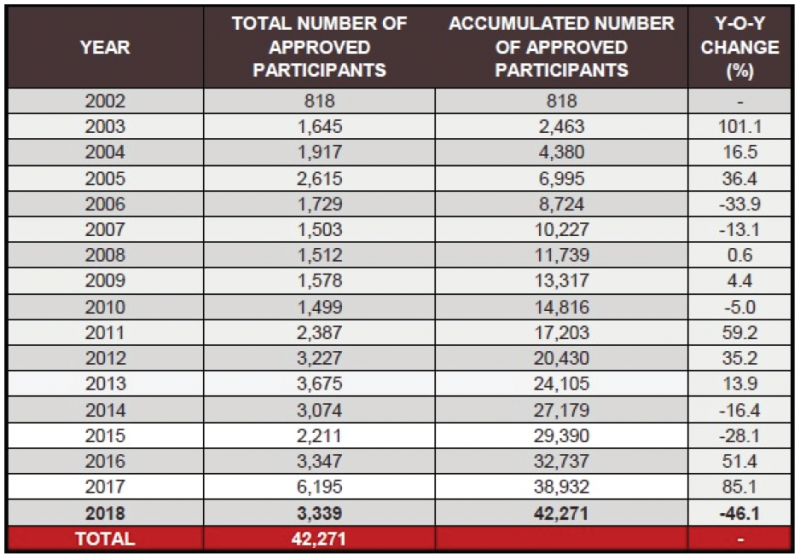
MM2H Approved Participants from 2002 to 2019
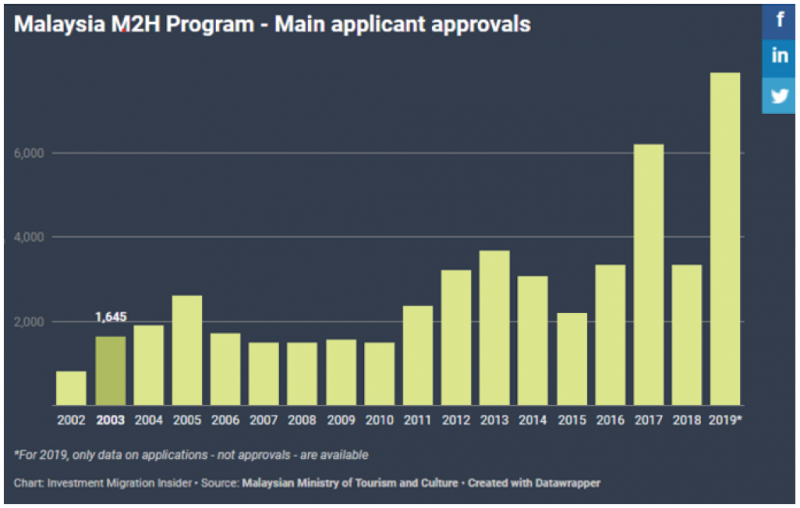
Data from MOTAC shows that the MM2H programme took some time to draw in foreign participants. In its first year in 2002, the programme had only 818 participants, but three years later in 2005 the programme had approved more than 2,600 applicants. Approvals peaked in 2017 with more than
6,000 approved applicants – almost double the rate of the previous year. Then, there is a significant decline of approved applicants the following year to around 3,500 applicants. It is not clear what caused the unusual rise and subsequent decline of approved applicants in 2017 and 2018. The sudden suspension of the programme in 2018 was a factor that year, undoubtedly.
By 2019, it had become increasingly difficult for applicants to get approval. More than 90% of all MM2H applications were rejected without any explanation between September and November that year.[10] Such an unusually high volume of rejections gave the impression that the MM2H programme was facing an unofficial suspension.[11]
MM2H Participants’ Nationality Distribution
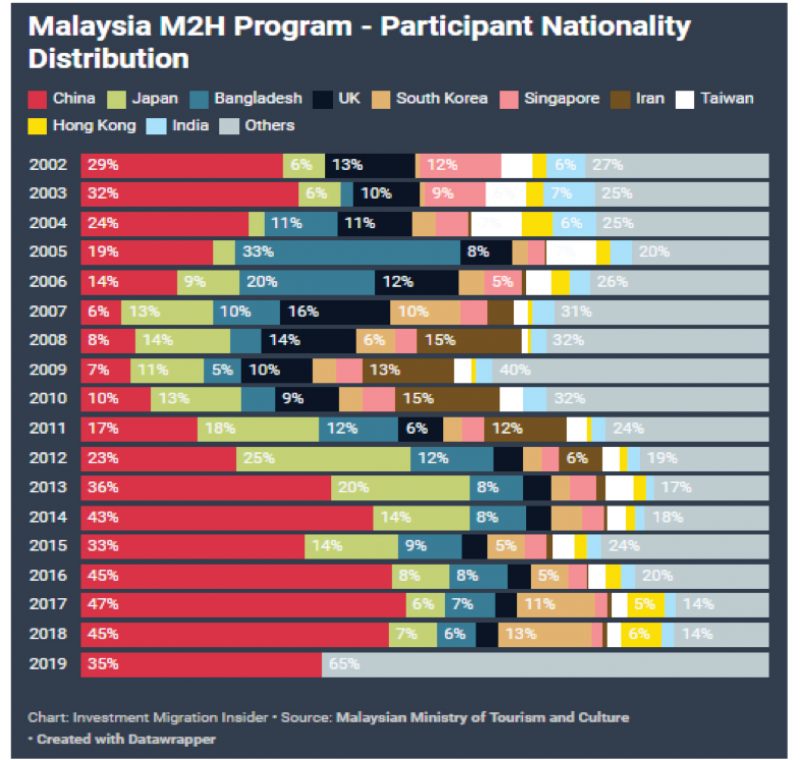
Applicants for the MM2H programme come from all over the world, with China and Japan at the top of the list. The MM2H programme has been particularly popular among Chinese property buyers, however, it is unclear on how many who actually make use of the visa to reside in Malaysia. Also, Malaysia has for a long time been a preferred destination for long-term residence for the Japanese, earning the country the Japan Longstay Foundation award.[12] The programme is also popular among applicants from Bangladesh, Europe (constituting 14.78% of the total MM2H participants from 2002 to 2013), and North America.[13]
Reasons for Applying for MM2H
In a 2019 survey conducted by TEG Media, an expatriate group, the main reasons why MM2H has been popular are:
1. To settle and retire in Malaysia
2. To spend extended periods here without having to apply for the visa
3. To set up a home for their family when the working spouse is employed outside Malaysia
4. To have a place to flee to if the situation in their own country becomes worse
5. To accompany their children while they are being educated in Malaysia
6. The possibility of property purchase
Apart from these reasons, the affordable cost of living, accessibility to medical facilities and educational institutions, the tropical climate, political stability, low crime rates, absence of natural disasters, the multicultural society, and English being widely spoken (and Chinese where Chinese speakers are concerned) also make Malaysia an attractive destination for applicants.
Previous and Current Requirements for MM2H Applicants
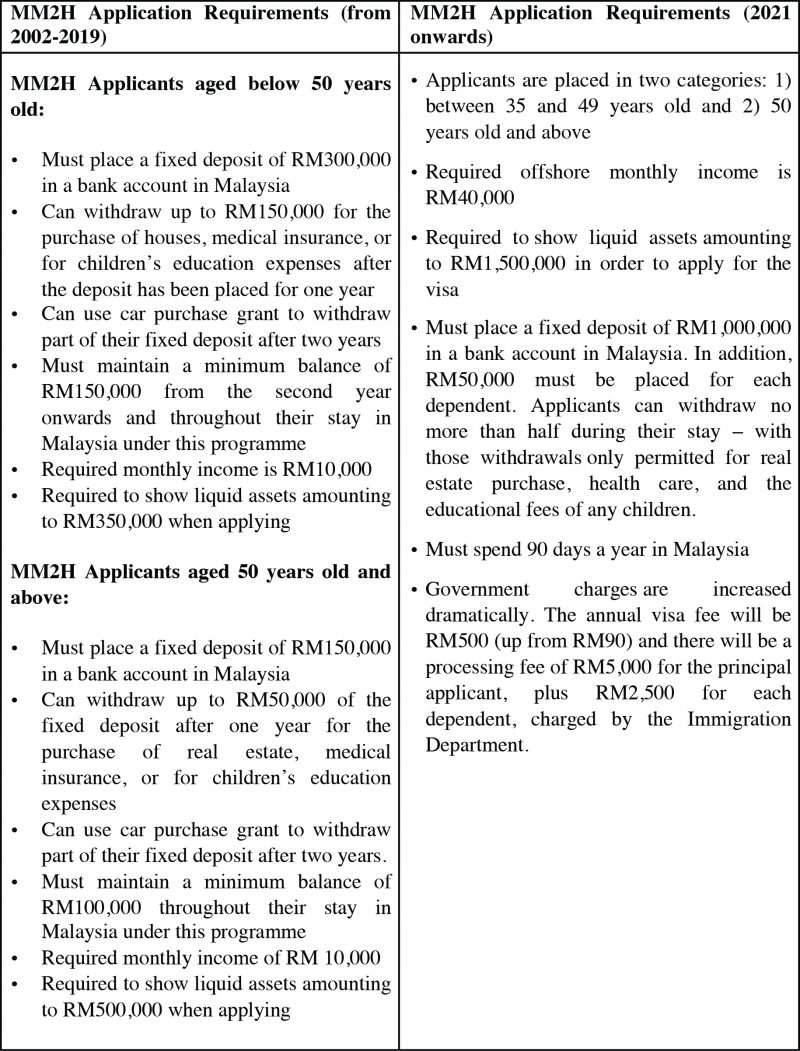
Arguably, one of the reasons that MM2H has been attractive to applicants is its affordable requirements. Understandably, the new stringent requirements have spurred many criticisms.
Firstly, there is a four-fold hike requirement on the monthly income of applicants. From a monthly income of RM10,000, the new criteria require applicants to have an offshore income of RM40,000. This can be quite a challenge for most retirees. Secondly, there is a substantial increase on the requirement for liquid assets from RM350,000 for those below 50 and RM500,000 for those above 50, to RM1.5 million. Applicants are also required to place a fixed deposit of RM1 million in a bank account in Malaysia with an additional RM50,000 for each dependent, and are only allowed to withdraw half of it for certain restricted purposes. This is very limiting for prospective applicants, especially if they are older and need a large sum of money for medical purposes.
While the government’s rationale to attract high income participants is valid, these drastic changes are bound to act as a huge deterrent on prospective applicants. Existing MM2H participants who do not meet these requirements may also be disqualified from the programme and be forced to leave the country.
Furthermore, the new MM2H arrangement only provides a visa that lasts five years instead of ten. Prospective applicants may not find it worthwhile to invest so much of their time and money to apply for a visa which only lasts for this short duration.
As mentioned, one of the attractions of the MM2H programme is the lower cost of living in Malaysia. Retirees could leverage on the currency exchange rate to have a better quality of life while younger adults could opt for an early retirement away from their home country. However, if these strict requirements are enforced, Malaysia will cease to be an attractive destination for retirement. Simply put, it will be too expensive to retire in Malaysia.
This turn of events bodes ill for the economy, especially at a time the national economy is in decline. As stated earlier, participants of MM2H contribute a significant amount to the Malaysian economy in terms of property purchases, rental, vehicles, immigration fees, and household spending. Should existing participants choose to leave, they will leave with their fixed deposits and no longer contribute to the economy. There will also be a spill-over effect on other industries, especially among those in which participants have invested. The exodus of MM2H expatriates may also lead to a loss of income for the tourism industry, as many of their family and friends visit them in Malaysia on tourist visas. Furthermore, the efforts of MOTAC and MM2H agents who have been promoting the programme for the past 19 years would have been wasted, and the image of the country would be tarnished.
The shift of administrative power from MOTAC to KDN also has widespread implications on the goals of the programme since the two departments have very different mandates. While MOTAC focuses on promoting tourism to bring in revenue, KDN’s mandate is primarily about security.
How does MM2H Fare against Similar Programmes in Neighbouring Countries?[14] [15] [16] [17]
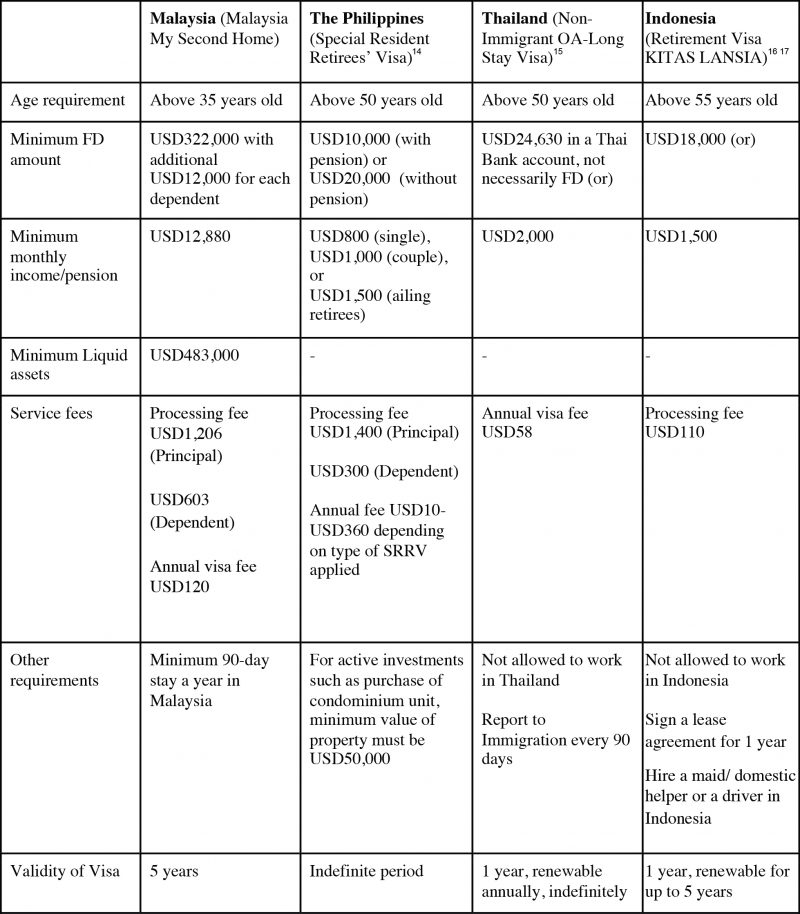
i. Non-exhaustive list
ii. The significantly younger age limit for MM2H applicants indicates that it is targeted at both high income and retired individuals.
iii. The retirement visa policies of The Philippines, Thailand, and Indonesia are chosen to be points of comparison with Malaysia’s MM2H due to the relatively similar costs of living in these countries. Singapore is intentionally excluded for comparison due to its significantly higher cost of living.
Source: Authors’ own compilation based on the Malaysia My Second Home Official Portal, the Philippine Retirement Authority, Thailand Department of Consular Affairs, and the Indonesian General Immigration Directorate.
In comparison with neighbouring countries such as Thailand, The Philippines and Indonesia, the latest financial requirements for MM2H applicants are far more demanding. Firstly, MM2H holders must maintain a fixed deposit account of minimum USD322,000. This is more than thirty times the required FD amount for retirement visa holders in The Philippines, who only need to maintain USD10,000 for those receiving pension and USD20,000 for those without a monthly pension. Retirement visa holders in Thailand and Indonesia also enjoy the flexibility of either maintaining a bank account with USD24,630 and USD18,000 a year respectively, or provide proof of receipt of monthly pensions of USD2,000 in Thailand and USD1,500 in Indonesia – a requirement that is much more flexible and easier to meet. Unlike Malaysia, Thailand and Indonesia do not impose a compulsory minimum FD amount on their retirement visa holders.
Furthermore, the low FD interest rates in Malaysia make it undesirable for prospective applicants to place that much money into a declining asset, especially when the Malaysian Ringgit has been steadily devaluing over the years, as compared to other currencies in the region such as the Thai Baht and the Singapore Dollar.
On top of the steep FD requirement, there is also a requirement that MM2H holders receive a minimum offshore income of USD12,880. The Philippines only requires their retirement visa holders to have a monthly pension of USD800 for principal single visa holders, USD1,000 for couples, and USD1,500 for ailing retirees. It is unlikely that individuals who choose to retire in a relatively affordable country like Malaysia continue to have a monthly income as high as USD12,880.
There is also an additional minimum liquid assets requirement of USD483,000 for MM2H holders whereas no such requirement is needed for retirement visa holders in The Philippines, Thailand and Indonesia. Liquid assets, or additional cash funds, do not include assets such as properties. Therefore, even high-earning applicants may rather place their money in investments like shares or properties and so do not necessarily have that much cash savings.
The steep minimum financial requirements for MM2H applicants would deter expatriates from choosing Malaysia as their home for retirement. They would instead prefer neighbouring countries with similar costs of living, weather conditions, culture, and security and which offer retirement visas with significantly more lenient conditions.
Policy recommendations
1. Gradual changes to programme requirements
Drastic changes in the MM2H requirements would cause many MM2H holders who have already settled in Malaysia to now be disqualified from the programme. Changes in the requirements should be gradual, and existing MM2H holders should be able to renew their visas under the same terms or with minimum changes.
2. Protecting National Interests and Attracting Applicants
There is no denying that previous requirements for the MM2H programme have had loopholes. While it is important to step up security measures to protect Malaysia’s interests, KDN might not find it within its mandate to actively promote the programme the way MOTAC did. Thus, the government should reconsider how KDN and MOTAC can coordinate more effectively.
3. Transparency about periodic reviews of requirements
Policy makers need to be transparent and more systematic about how often MM2H requirements are reviewed, and publicise a long-term plan. A more flexible system would also allow the government to adjust requirements according to inflation rates and other considerations.
4. Encourage MM2H holders to contribute to the economy
Apart from their expenditure on properties and other investments which contribute to the nation’s income, MM2H holders serve as drivers of the economy as they bring with them different experiences and skills. Hence, they should be incentivised to start businesses in Malaysia. Alternatively, those who have expertise and skills should be encouraged to contribute to the economy.
For list of references and appendix, kindly download the document to view.
Editor: Ooi Kee Beng
Editorial Team: Sheryl Teoh, Alexander Fernandez and Nur Fitriah (Designer)
[1] Nora Mahpar. 2021. Don’t worry, Hamzah tells current MM2H holders, Free Malaysia Today, https://www.freemalaysiatoday.com/category/nation/2021/09/01/dont-worry-hamzah-tells-current-mm2h-holders/
[2] Brian KM Wong and Ghazali Musa. 2017. Malaysia My Second Home (MM2H): Retirees’ demographic profile and spending dynamics. Tourism Management. Vol 60. pp.42-26 https://www.sciencedirect.com/science/article/abs/pii/S0261517 716302138?via%3Dihub
[3] Syed Danial Syed Azahar. 2019. Chinese Nationals most attracted to MM2H programme, The Sun Daily, https://www.thesundaily.my/local/chinese-nationals-most-attracted-to-mm2h-programme-updated-KD1126480 and The Malay Mail, 2020. Survey Ranks Malaysia as Seventh best place to retire https://www.malaymail.com/news/malaysia/ 2020/01/03/survey-ranks-malaysia-as-seventh-best-place-to-retire-in-2020/1824510
[4] Seri Nor Nadiah Koris. 2017. 33,000 people from 126 countries accepted Malaysia My 2nd Home, New Straits Times https://www.nst.com.my/news/nation/2017/07/257060/33000-people-126-countries-accepted-msia-my-2nd-home-nazri
[5] Kang SL. 2021. Special Report: Second Home Dream Crushed Pandemic puts MM2H in Limbo, The Edge Markets, https://www.theedgemarkets.com/article/special-report-second-home-dream-crushed-pandemic-puts-mm2h-limbo
[6] Abdul-Rashid AZ, Loh CL and Jaafar M. 2014. Malaysia’s My Second Home (MM2H) Programme: An examination of Malaysia as destination for international retirees. Tourism Management, Vol 40: 203- 212
[7] TEG Media.2019. Survey of People Holding the MM2H Visa. Bangsar: Kuala Lumpur
[8] Kang SL. 2021. Special Report: Second Home Dream Crushed Pandemic puts MM2H in Limbo, The Edge Markets, https://www.theedgemarkets.com/article/special-report-second-home-dream-crushed-pandemic-puts-mm2h-limbo
[9] The Star.2021. Immigration Department to take over MM2H Applications from October, https://www.thestar. com.my/news/nation/2021/08/27/immigration-dept-to-take-over-mm2h-applications-from-october
[10] Bedi R. 2020. More than 90% of MM2H applications from Sep –Nov2019 rejected, claims agents association, The Star
Online, https://www.thestar.com.my/news/nation/2020/07/02/more-than-90-of-mm2h-applications-from-sep-nov-2019- rejected-claims-agents-association
[11] Neishim C. 2021. After 21 months, no end in sight for MM2H suspension-Political Turf War to blame, say insiders, Investment Migration Insider, https://www.imidaily.com/editors-picks/after-21-months-no-end-in-sight-for-mm2h- suspension-political-turf-war-to-blame-say-insiders/
[12] Syed Danial Syed Azahar. 2019. Chinese Nationals most attracted to MM2H programme, The Sun Daily, https:/
/www.thesundaily.my/local/chinese-nationals-most-attracted-to-mm2h-programme-updated-KD1126480
[13] Ministry of Tourism Malaysia. 2013. MM2H. Malaysia my Second Home Programme Performance from 2002 – March 2013
[14] Philippine Retirement Authority. (n.d.). The SRR Visa. Republic of The Philippines Department of Tourism, https://pra.gov
.ph/srrv/
[15] Department of Consular Affairs. 16 August 2017. Non-Immigrant OA-Long Stay Visa. Thai Consular, https://consular.mfa
.go.th/
[16] Indonesia General Immigration Directorate. 2021. Retirement Visa KITAS. Ditjen Imigrasi Republik Indonesia, https://www. imigrasi.go.id/en/
[17] VisaGuide. World. 2021. Complete Guide to Obtaining a Visa to Retire in Indonesia. VisaGuide.World, https://visaguide. world/asia/indonesia-visa/retirement/
You might also like:
![Fiqh al-Muwatanah (Fiqh of Citizenship): A New and Inclusive Islamic Approach for Multi-religious So...]()
Fiqh al-Muwatanah (Fiqh of Citizenship): A New and Inclusive Islamic Approach for Multi-religious So...
![Persevering towards Recovery for Penang’s Tourism Industry]()
Persevering towards Recovery for Penang’s Tourism Industry
![Sebatan di khalayak secara mandatori boleh menjadi trend nasional]()
Sebatan di khalayak secara mandatori boleh menjadi trend nasional
![ESG Disclosures among Public-listed Companies Based in Penang]()
ESG Disclosures among Public-listed Companies Based in Penang
![Tighter Collaboration Needed in Penang’s Skills Development Infrastructure]()
Tighter Collaboration Needed in Penang’s Skills Development Infrastructure

